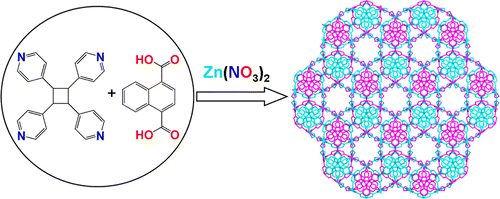Ming Dai †‡, Xin-Ran Su †, Xiao Wang †, Bing Wu †, Zhi-Gang Ren *†§ (任志刚), Xuan Zhou †, and Jian-Ping Lang *†‡ (郎建平)
† College of Chemistry, Chemical Engineering and Materials Science, Soochow University, Suzhou 215123, People’s Republic of China
‡ State Key Laboratory of Organometallic Chemistry, Shanghai Institute of Organic Chemistry, Chinese Academy of Sciences, Shanghai 200032, People’s Republic of China
§
Cryst. Growth Des. 2014, 14, 240–248
Solvothermal reactions of Zn(NO3)2 with tetrakis(4-pyridyl)cyclobutane (tpcb) and 1,4-naphthalenedicarboxylic acid (1,4-H2ndc) and 2,3-naphthalenedicarboxylic acid (2,3-H2ndc) in different solvents led to the formation of three polydimensional coordination polymers {[Zn2(H2O)(1,4-ndc)2(tpcb)]}n (1), {[Zn(1,4-ndc)(tpcb)0.5]}n (2), and {[Zn2(H2O)(2,3-ndc)2(tpcb)]}n (3). Compounds 1–3 were characterized by elemental analysis, IR, powder X-ray diffraction (PXRD), and single crystal X-ray diffraction. Compound 1 is a three-dimensional (3D) (3,3)-connected net with a (10·122)·(102·12) Schläfli symbol. Compound 2 holds a 2-fold interpenetrating 3D framework with a (42·62·72)·(4·62·73) Schläfli symbol, which shows hexagonal-prism-like one-dimensional channels. Compound 3 shows a two-dimensional (3,8)-connected network. The solid state luminescent, optical, and thermal stability properties of 1–3 at ambient temperature were also investigated. A comparative study on their photocatalytic activity toward the degradation of methyl orange and methyl blue in polluted water was explored. The results provided some interesting insights into solvent effects on the structures of zinc(II) coordination polymers and their photocatalytic applications.

链接: //pubs.acs.org/doi/abs/10.1021/cg4014416